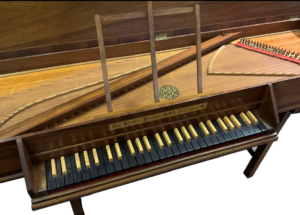Virginal Alec Hodsdon 1961
Description

| Date: | 1961 |
| Origin: | Lavenham Suffolk - England |
| Serialnumber: |
The virginal is a keyboard instrument that was widely used in Europe in the 16th and 17th centuries. It belongs to the family of keyboard instruments and is closely related to the spinet and the harpsichord. The virginal has a very clear, percussive sound and was especially popular in Renaissance and Baroque music. The origins of the virginal are not exactly known, but it is thought to have originated in Italy in the early 16th century. The name “virginal” comes from the Latin word “virgo“, which means “virgin“. This refers to the original use of the instrument as an accompaniment to church songs, which were supposedly sung by virgins. The virginal became increasingly popular during the 16th century and spread throughout Europe. In the 17th century it was supplanted by other keyboard instruments, especially the harpsichord, but remained a popular instrument until the end of the century. The virginal was an important part of Renaissance and Baroque music and was used by many famous composers such as William Byrd (1543 – 1623), John Bull (1562 – 1628) and Orlando Gibbons (1583 – 1625). Likewise, the instrument was also used to accompany singing and in combination with other instruments. In addition to the musical aspect, the virginal was also often a status symbol of wealthy families, as the instruments were often elaborately decorated.

Virginal Alec Hodsdon, Lavenham 1961 – Eric Feller Collection (2)
The virginal presented here was made by Alec Hodsdon in Lavenham/England in 1961. The case is made of walnut and decorated with beautiful inlays all around (also the inside of the lid). The virginal stands on a trestle-stand. The nameboard bears the signature in an inlaid cartouche:
“Alec Hodsdon Lavenham Suffolk fecit anno 1961”
The soundboard is made of spruce with two bridges, wooden jacks and Delrin plectra. The keys are made of ebony and sycamore maple.

Virginal Alec Hodsdon, Lavenham 1961 – Eric Feller Collection (3)
The sound is very rich in overtones and the instrument has a variety of timbres. These timbres are due to the construction, as the instrument has two bridges that rest on the soundboard.

Virginal Alec Hodsdon, Lavenham 1961 – Eric Feller Collection (5)
Unfortunately, little is known about Alec Hodsdon. He was born in Sidcup, Kent in 1900 and studied chemistry. In 1916 he met Margaret Fletcher in Brighton, the niece of Major George Henry Benton Fletcher (1866 – 1944), who became famous for his collection of historical instruments (which are on display and can be seen at Fenton House, National Trust, Hampstead). Margaret and Alec married and moved into an old timber-framed house in Lavenham in Suffolk. Due to the good financial situation resulting from his marriage to Margaret Fletcher, who came from a wealthy family, Alec Hodsdon stopped working as a chemist. Among his most important hobbies were steam-driven cars and model railways. Through his own interest but especially from his wife’s musical background, he began to build historical keyboard instruments and opened a workshop.

Advert by Alec Hodsdon in The Musical Times 1944
In his early days Hodsdon was very experimental and produced a wide range of instruments of all kinds, including a number of highly complex harpsichords and other period instruments. Some of his harpsichords had metal constructions to guarantee better tuning. However, he did not follow the continental trend and increasingly built instruments with 16′ stops (in tradition of the so-called “Bach harpsichord“, which was usually used as a model for new instruments at the beginning of the 20th century), like his colleague Arnold Dolmetsch (1858 – 1940). Through his wife’s reference and access to original historical instruments in the Fletcher Collection, Hodsdon later oriented himself towards original instruments. In his workshop he worked together with Fred Sykes and other employees. Fred Sykes came from nearby Sudbury and worked as a furniture maker after his former company went bankrupt and he had to give up his job as a harmonium maker. In addition to building new instruments, Hodsdon’s workshop also restored historic instruments.

Advert by Alec Hodsdon in The Musical Times 1947
Often his clavichords and harpsichords turned out to have structural defects. His virginals, on the other hand, were characterised by solid workmanship and a particularly beautiful sound and quickly advanced to become popular instruments with musicians and composers. As one of the first builders of period keyboard instruments in England, Hodsdon is of great importance. Through him, the revival of the construction of historical keyboard instruments and historical performance practice in Great Britain was strongly influenced. Alec Hodsdon retired from his business in the late 1960s while Fred Sykes continued to produce instruments under Hodsdon’s brand. He soon discontinued this and built instruments under his own name.
Alec Hodsdon died in Lavenham on 11 December 1986.
| Length: | 148 cm |
| Width: | 51 cm |
| Height: | 20 cm |
| Circumference: | 4 ½ octaves (CC – f3) |
| Mechanics: | wooden jacks with delrin quills |
| Pedals: | --- |
| Signature: | „Alec Hodsdon Lavenham Suffolk fecit anno 1961” |

